October 7th, 2017 - Halloween Music : Unearthing Treasures

What makes a Halloween song a hit? Most folks agree that a great Halloween song is one that you can sing along with. Songs that you find yourself humming as you decorate or prepare for Halloween. Many of these songs can be found easily and are considered common favorites among fans of the holiday. So why are some Halloween songs destined to live in obscurity? In the last issue of Happy Halloween Magazine I wrote about some of the better known Halloween classics. In this issue I’ll discuss more obscure songs that deserve their place in Halloween music history.
 My earliest memories of Halloween music were of songs from classic cartoons that used pop, jazz and swing music from the 20s, 30s and 40s. Artists like Louis Armstrong, Tommy Dorsey, Ray Noble and Bing Crosby recorded some of the best-known yet forgotten Halloween hits around. I love old black and white spooky cartoons. The Haunted House, written by Ray Noble and Max Kester is one of those "cartoon" songs I can remember from my childhood. Recorded in London on October 23, 1931, the Noble led New Mayfair Dance Orchestra, along with The Three Ginx on vocals, capture the fun, frivolity and mischief of the holiday. There is little information regarding this song and the history behind it. I contacted Ray’s nephew, Bud Noble, but he wasn’t able to shed any light on the subject. At this time the song remains a mystery.
My earliest memories of Halloween music were of songs from classic cartoons that used pop, jazz and swing music from the 20s, 30s and 40s. Artists like Louis Armstrong, Tommy Dorsey, Ray Noble and Bing Crosby recorded some of the best-known yet forgotten Halloween hits around. I love old black and white spooky cartoons. The Haunted House, written by Ray Noble and Max Kester is one of those "cartoon" songs I can remember from my childhood. Recorded in London on October 23, 1931, the Noble led New Mayfair Dance Orchestra, along with The Three Ginx on vocals, capture the fun, frivolity and mischief of the holiday. There is little information regarding this song and the history behind it. I contacted Ray’s nephew, Bud Noble, but he wasn’t able to shed any light on the subject. At this time the song remains a mystery.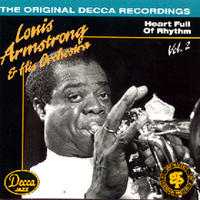 Big band, swing and jazz music was big in my house. I loved to see the cartoons that brought together the familiar musical sounds with Halloween flair. A perfect match. Also big in my house were old movies. The Louis Armstrong version of the Arthur Johnson/Johnny Burke tune, The Skeleton in the Closet recorded with Jimmy Dorsey and His Orchestra in Los Angeles, August 7, 1936 and featured in the 1936 Columbia Pictures movie, Pennies from Heaven is another favorite of mine. This was Satchmo’s big break as he was featured in a role aside Bing Crosby in this very successful romantic musical comedy. The song is featured in a creepy nightclub sequence complete with a dancing skeleton. Who can resist Armstrong’s gravelly voice and legendary trumpet style especially when it’s put to good use on a Halloween tune!
Big band, swing and jazz music was big in my house. I loved to see the cartoons that brought together the familiar musical sounds with Halloween flair. A perfect match. Also big in my house were old movies. The Louis Armstrong version of the Arthur Johnson/Johnny Burke tune, The Skeleton in the Closet recorded with Jimmy Dorsey and His Orchestra in Los Angeles, August 7, 1936 and featured in the 1936 Columbia Pictures movie, Pennies from Heaven is another favorite of mine. This was Satchmo’s big break as he was featured in a role aside Bing Crosby in this very successful romantic musical comedy. The song is featured in a creepy nightclub sequence complete with a dancing skeleton. Who can resist Armstrong’s gravelly voice and legendary trumpet style especially when it’s put to good use on a Halloween tune!
 No list of Halloween songs from this era would be complete without mentioning The Headless Horseman by Don Raye and Gene De Paul. Harry Lillis "Bing" Crosby and the Rhythmaires perform the song featured in the "Legend Of Sleepy Hollow," a portion of the 1947 animated Walt Disney film The Adventures of Ichabod and Mr. Toad. Bing plays the role of Brom Bones and his song follows the Washington Irving tale of a headless man who cannot be reasoned, who is intent on scaring poor Ichabod Crane witless on Halloween night.
No list of Halloween songs from this era would be complete without mentioning The Headless Horseman by Don Raye and Gene De Paul. Harry Lillis "Bing" Crosby and the Rhythmaires perform the song featured in the "Legend Of Sleepy Hollow," a portion of the 1947 animated Walt Disney film The Adventures of Ichabod and Mr. Toad. Bing plays the role of Brom Bones and his song follows the Washington Irving tale of a headless man who cannot be reasoned, who is intent on scaring poor Ichabod Crane witless on Halloween night.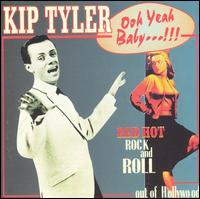 The 50s and 60s gave real life to Halloween music. Rockabilly (a blend of the blues, country and gospel) and rock-n-roll songs are most easily identified with Halloween and put music into the celebration of Halloween. The Purple People Eater, The Monster Mash and I Put A Spell On You are all products of this era. Monster magazines and movies influenced musicians to join the ranks of those who create media for the holiday. There are so many great songs from this era, many completely unknown and little is known about the artists who recorded some of these excellent yet obscure songs. She’s My Witch by Kip Tyler & His Flips was recorded in November 1958. Sexy, spooky and lazy this is Halloween music performed with a hoodlum’s sneer. The Flips were a Hollywood black-leather clad Rockabilly gang who would ride to their shows on motorcycles. Guitarist Bruce Johnson later joined the Beach Boys. Tyler, who also recorded under the name Jimmy Daley, made an appearance in the film Rock Pretty Baby, but only dabbled once with Halloween music.
The 50s and 60s gave real life to Halloween music. Rockabilly (a blend of the blues, country and gospel) and rock-n-roll songs are most easily identified with Halloween and put music into the celebration of Halloween. The Purple People Eater, The Monster Mash and I Put A Spell On You are all products of this era. Monster magazines and movies influenced musicians to join the ranks of those who create media for the holiday. There are so many great songs from this era, many completely unknown and little is known about the artists who recorded some of these excellent yet obscure songs. She’s My Witch by Kip Tyler & His Flips was recorded in November 1958. Sexy, spooky and lazy this is Halloween music performed with a hoodlum’s sneer. The Flips were a Hollywood black-leather clad Rockabilly gang who would ride to their shows on motorcycles. Guitarist Bruce Johnson later joined the Beach Boys. Tyler, who also recorded under the name Jimmy Daley, made an appearance in the film Rock Pretty Baby, but only dabbled once with Halloween music.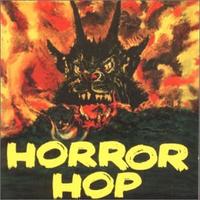 Gary Warren’s Werewolf was recorded August 18, 1958 on the Nasco label. Re-recorded in 1998 by Southern Culture On The Skids (who also have a great version of She’s My Witch) for Rob Zombie’s Halloween Hootenanny CD, Werewolf has to be one of my favorite Halloween songs of all time. This is one of the most fun songs to sing and practice Elvis moves to. I find myself singing this one whenever I feel a sinister urge coming on. Unfortunately, little is known about Gary Warren or his recording career. I’ve contacted the Rockabilly Hall of Fame in hopes of learning more about Gary Warren and Kip Tyler. I’ll keep you posted.
Gary Warren’s Werewolf was recorded August 18, 1958 on the Nasco label. Re-recorded in 1998 by Southern Culture On The Skids (who also have a great version of She’s My Witch) for Rob Zombie’s Halloween Hootenanny CD, Werewolf has to be one of my favorite Halloween songs of all time. This is one of the most fun songs to sing and practice Elvis moves to. I find myself singing this one whenever I feel a sinister urge coming on. Unfortunately, little is known about Gary Warren or his recording career. I’ve contacted the Rockabilly Hall of Fame in hopes of learning more about Gary Warren and Kip Tyler. I’ll keep you posted.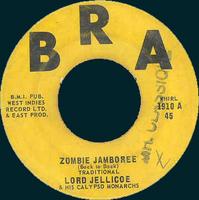 Calypso, Reggae and Ska also have some excellent seasonal representatives. Zombie Jamboree is a funny story about zombies from across the land celebrating at a cemetery on Long Island and is said to have won an extemporaneous composition contest for Lord Invader and his Twelve Penetrators at Trinidad’s Calypso Carnival in 1955. This, according to the Kingston Trio’s Dave Guard, who has a knack for entertaining song lead-ins. The song was actually written by Conrad Eugene Mauge, Jr. (which is not Lord Invader’s real name—he was born Rupert Westmore Grant); Lord Invader’s band was known as his Calypso Orchestra. No matter, the Kingston Trio is responsible for one of the most notable versions of this song. Early recordings of Zombie Jamboree (which is also known as Back to Back [Belly to Belly]) are by such Calypso artists as Noel Anthony, The Castaways, Lord Jellicoe and His Calypso Monarchs and The Charmer (The Charmer was Louis Farrakhan’s stage name back in the 50s). Harry Belafonte recorded my favorite version of Zombie Jamboree in 1962. In 1990, Rockapella (an acappella group) released a radio only single of Zombie Jamboree (one of the first songs they had recorded as a group) bringing the song to a new audience and making the song hip again.
Calypso, Reggae and Ska also have some excellent seasonal representatives. Zombie Jamboree is a funny story about zombies from across the land celebrating at a cemetery on Long Island and is said to have won an extemporaneous composition contest for Lord Invader and his Twelve Penetrators at Trinidad’s Calypso Carnival in 1955. This, according to the Kingston Trio’s Dave Guard, who has a knack for entertaining song lead-ins. The song was actually written by Conrad Eugene Mauge, Jr. (which is not Lord Invader’s real name—he was born Rupert Westmore Grant); Lord Invader’s band was known as his Calypso Orchestra. No matter, the Kingston Trio is responsible for one of the most notable versions of this song. Early recordings of Zombie Jamboree (which is also known as Back to Back [Belly to Belly]) are by such Calypso artists as Noel Anthony, The Castaways, Lord Jellicoe and His Calypso Monarchs and The Charmer (The Charmer was Louis Farrakhan’s stage name back in the 50s). Harry Belafonte recorded my favorite version of Zombie Jamboree in 1962. In 1990, Rockapella (an acappella group) released a radio only single of Zombie Jamboree (one of the first songs they had recorded as a group) bringing the song to a new audience and making the song hip again. Reggae super-producer Lee "Scratch" Perry and his studio band, that he called The Upsetters, released Dracula in January 1971 as an instrumental b-side to The Wailers Mr. Brown single. Years earlier after a couple of rehearsals, Bob Marley and The Wailers had convinced The Upsetters to leave Perry and join The Wailers. When Perry heard the news, he was livid. After locking themselves away for several hours, Perry and Marley decided to work together, sharing the backing musicians and making Perry exclusive producer for future recordings. They worked together from 1969-1971. Released on Perry’s Upsetter label, Dracula features his signature fiery organ-led, soul-tinged reggae and is a truly one of the coolest Halloween instrumentals around. The relationship between Perry, The Upsetters and The Wailers was a turning point in reggae history. The song is little known and often credited to Bob Marley.
Reggae super-producer Lee "Scratch" Perry and his studio band, that he called The Upsetters, released Dracula in January 1971 as an instrumental b-side to The Wailers Mr. Brown single. Years earlier after a couple of rehearsals, Bob Marley and The Wailers had convinced The Upsetters to leave Perry and join The Wailers. When Perry heard the news, he was livid. After locking themselves away for several hours, Perry and Marley decided to work together, sharing the backing musicians and making Perry exclusive producer for future recordings. They worked together from 1969-1971. Released on Perry’s Upsetter label, Dracula features his signature fiery organ-led, soul-tinged reggae and is a truly one of the coolest Halloween instrumentals around. The relationship between Perry, The Upsetters and The Wailers was a turning point in reggae history. The song is little known and often credited to Bob Marley.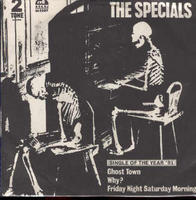 Another favorite is Ghost Town by The Specials. Written by Jerry Dammers (their keyboard player and principal songwriter) in 1981, Ghost Town was The Specials last single. The Specials were the flagship band of the late 70s/early 80s 2-tone Ska scene, fusing Jamaican Ska (a mix of Reggae and Rocksteady) with high-energy Punk Rock. The song sums up the frustration felt by the band as youth riots erupted across England due to recession and high unemployment. It also captures a perfect feeling of desolation. Ghost Town reached Number 1 in the UK in July 1981 and stayed at Number 1 for three weeks.
Another favorite is Ghost Town by The Specials. Written by Jerry Dammers (their keyboard player and principal songwriter) in 1981, Ghost Town was The Specials last single. The Specials were the flagship band of the late 70s/early 80s 2-tone Ska scene, fusing Jamaican Ska (a mix of Reggae and Rocksteady) with high-energy Punk Rock. The song sums up the frustration felt by the band as youth riots erupted across England due to recession and high unemployment. It also captures a perfect feeling of desolation. Ghost Town reached Number 1 in the UK in July 1981 and stayed at Number 1 for three weeks.What makes these Halloween songs great is the mood they create and the fun they inspire. Whatever the type of music you enjoy there is a wealth of Halloween music to choose from. I will continue to research and discover the stories behind Halloween songs and present those stories in future issues of Happy Halloween Magazine.
 Mark Harvey is a Halloween music enthusiast and archivist. Mark owns and operates NobodyRecords.com, HauntScapes.com, Pumpkinland Studios and 13thTrack.com Halloween Radio plus a number of other Halloween and non-Halloween related websites. His own Halloween releases include the Pumpkinland Halloween ‘HauntScape’ Trilogy and Rain Station’s DARK RIDE.
Mark Harvey is a Halloween music enthusiast and archivist. Mark owns and operates NobodyRecords.com, HauntScapes.com, Pumpkinland Studios and 13thTrack.com Halloween Radio plus a number of other Halloween and non-Halloween related websites. His own Halloween releases include the Pumpkinland Halloween ‘HauntScape’ Trilogy and Rain Station’s DARK RIDE.Article from Happy Halloween Magazine Volume 5/Issue 1 – Spring 2002






